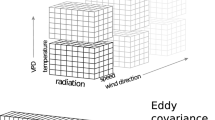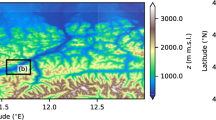Abstract
In weak wind stable conditions, eddy-correlation fluxes calculated using conventional averaging times of 5 min or longer to define the perturbations are severely contaminated by poorly sampled mesoscale motions. A method is developed to identify the averaging time for each individual data record that captures the turbulence while excluding most of the mesoscale motions. The method is based on multiresolution decomposition of the heat flux, and provides an objective procedure for selecting the averaging time for calculating eddy-correlation fluxes. Eddy-correlation data collected in weak turbulence conditions over grass, snow, a pine forest and the ocean are used to demonstrate the approach.
When the small-scale turbulence and mesoscale motions are clearly separated by a gap region in the heat flux cospectra, the variable window width reduces the influence of nonstationarity by more effectively filtering out mesoscale motions compared to traditional methods using constant averaging time. For records where turbulence and mesoscale motions overlap in scale, the method is not well posed, although such records occur infrequently for our datasets. These ambiguous cases correspond to significant nonstationarity at scales that overlap with turbulence scales. The improved turbulence fluxes calculated with the proposed method are the appropriate fluxes for evaluating flux-gradient relationships and Monin–Obukov similarity theory for developing improved model parameterizations of turbulence for weakly turbulent flows
Similar content being viewed by others
References
Andreas E. (2002). ‘Parameterizing Scalar Transfer Over Snow and Ice: A Review’. J. Hydrometeorol 3:417–432
Friehe C.A., Shaw W.J., Rogers D.P., Davidson K.L., Large W.G., Stage S.A., Crescenti G.H., Khalsa S.J.S., Greenhut G.K., Li F. (1991). ‘Air-Sea Fluxes and Surface-Layer Turbulence Around a Sea Surface Temperature Front’. J. Geophys 96:8593–8609
Howell J.F., Mahrt L. (1997). ‘Multiresolution Flux Decomposition’. Boundary-Layer Meteorol 83:117–137
Howell J.F., Sun J. (1999). ‘Surface-Layer Fluxes in Stable Conditions’, Boundary-Layer Meteorol 90:495–520
Kaimal J.C., Finnigan J.J. (1994). Atmospheric Boundary Layer Flows, Their Structure and Measurements. Oxford University Press, Oxford pp. 289
Klipp C., Mahrt L. (2004). ‘Flux-Gradient Relationship, Self-Correlation and Intermittency in the Stable Boundary Layer’. Quart. J. Roy. Meteorol. Soc. 130:2087–2103
Mahrt L., Moore E., Vickers D., Jensen N.O. (2001). ‘Dependence of Turbulent and Mesoscale Velocity Variances on Scale and Stability’. J. Appl. Meteorol 40:628–641
Mahrt L., Vickers D. (2005). ‘Moisture Fluxes Over Snow With and Without Protruding Vegetation’. Quart. J. Roy. Meteorol. Soc. 131:1251–1270
Mallat S.G. (1989). ‘The Theory of Multiresolution Signal Decomposition: the Wavelet Representation’. IEEE Trans. Pattern Anal. Machine Intell. 7:674–693
Oncley S.P., Friehe C.A., LaRue J.C., Businger J.A., Itsweire E.C., Chang S.S. (1996). ‘Surface-Layer Fluxes, Profiles, and Turbulence Measurements Over Uniform Terrain Under Near-neutral Conditions’. J. Atmos. Sci. 53:1029–1044
Panofsky H.A., Dutton J.A. (1984). Atmospheric Turbulence – Models and Methods for Engineering Applications. John Wiley and Sons, New York 397 pp.
Poulos G.S., Blumen W., Fritts D., Lundquist J., Sun J., Burns S., Nappo C., Banta R., Newsone R., Cuxart J., Terradellas E., Balsley B., Jensen M. (2002). ‘CASES-99: A Comprehensive Investigation of the Stable Nocturnal Boundary Layer’. Bull. Amer. Meteorol Soc. 83:555–581
Sakai R.K., Fitzjarrald D.R., Moore K.E. (2001). ‘Importance of Low-Frequency Contributions to The Eddy Fluxes Observed Over Rough Surfaces’. J. Appl. Meteorol 40:2178–2192
Smedman A.S. (1988). ‘Observations of Multi-Level Turbulence Structure in a Very Stable Atmospheric Boundary Layer’. Boundary-Layer Meteorol 44:231–253
Smedman A.S., Högström U. (1975). ‘Spectral Gap in Surface-Layer Measurements’. J. Atmos. Sci. 32:340–350
Vickers D., Mahrt L. (1997). ‘Quality Control and Flux Sampling Problems for Tower and Aircraft Data’. J. Atmos. Oceanic. Tech. 14:512–526
Vickers D., Mahrt L. (2003). ‘The Cospectral Gap and Turbulent Flux Calculations’. J. Atoms. Oceanic. Tech. 20:660–672
Author information
Authors and Affiliations
Corresponding author
Rights and permissions
About this article
Cite this article
Vickers, D., Mahrt, L. A Solution for Flux Contamination by Mesoscale Motions With Very Weak Turbulence. Boundary-Layer Meteorol 118, 431–447 (2006). https://doi.org/10.1007/s10546-005-9003-y
Received:
Revised:
Accepted:
Published:
Issue Date:
DOI: https://doi.org/10.1007/s10546-005-9003-y




